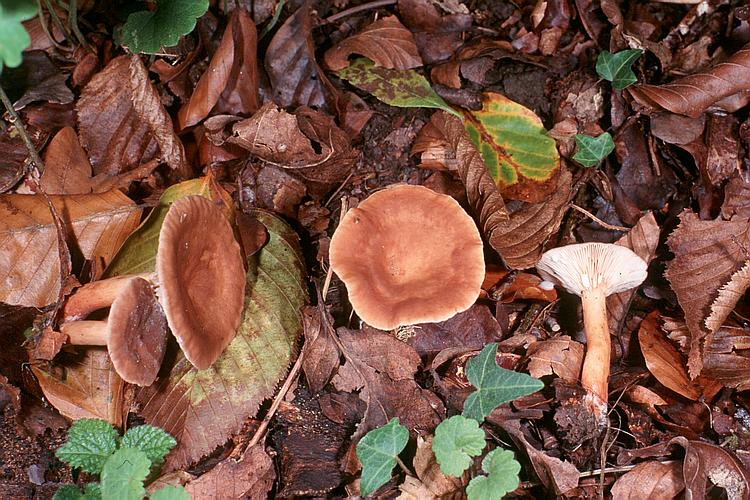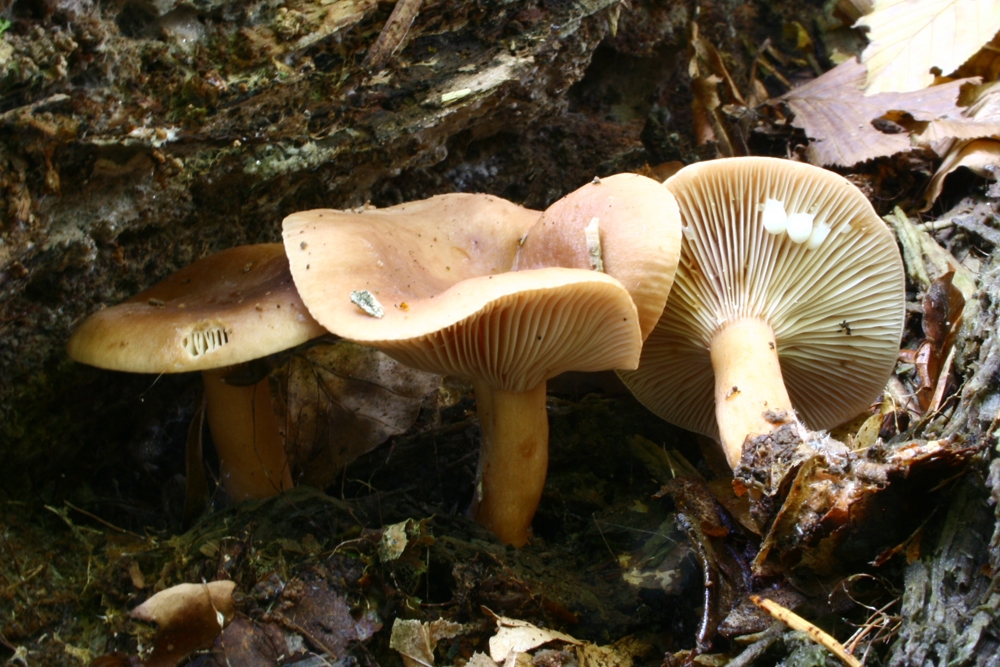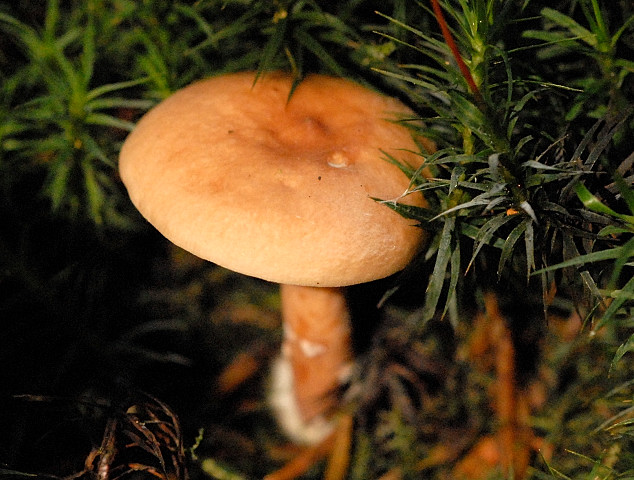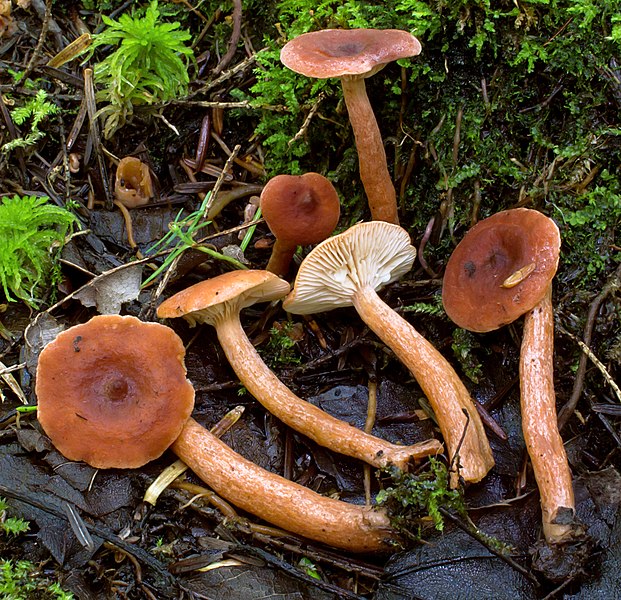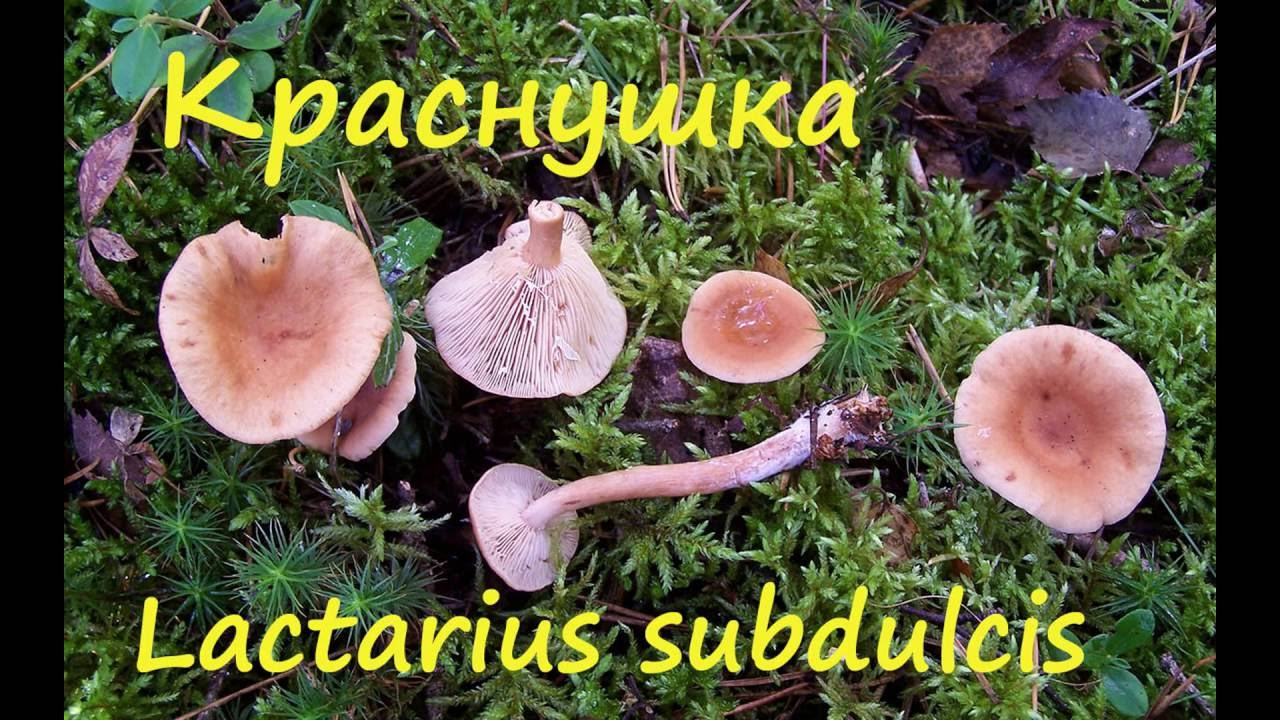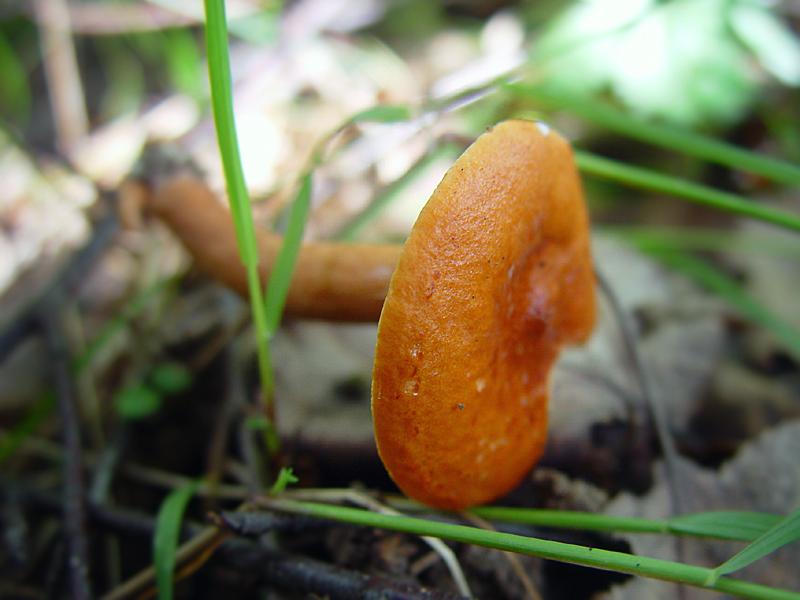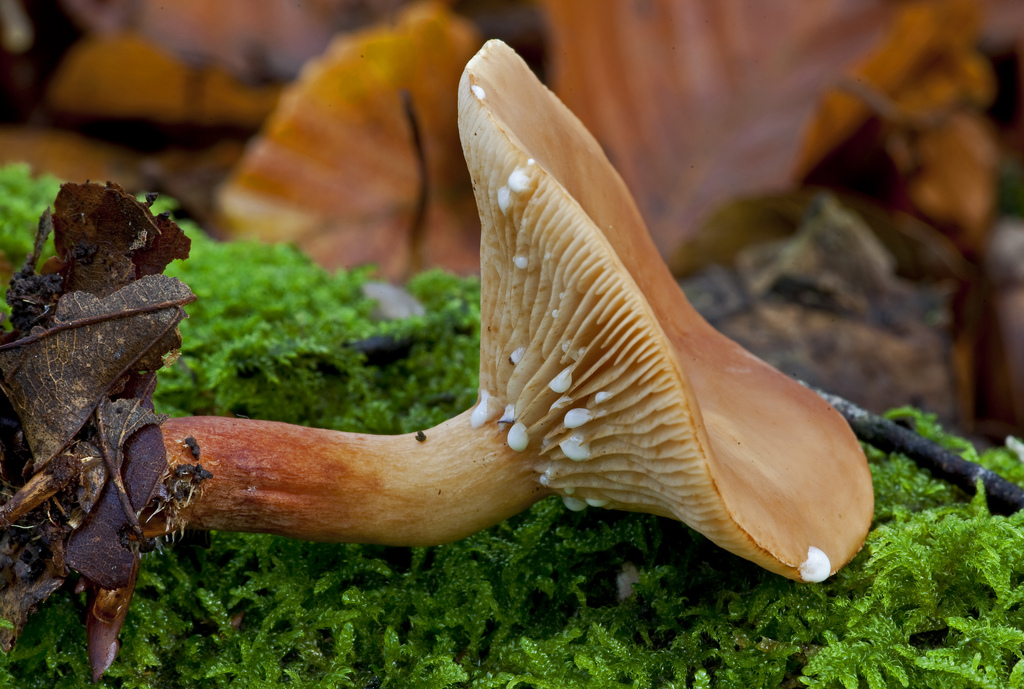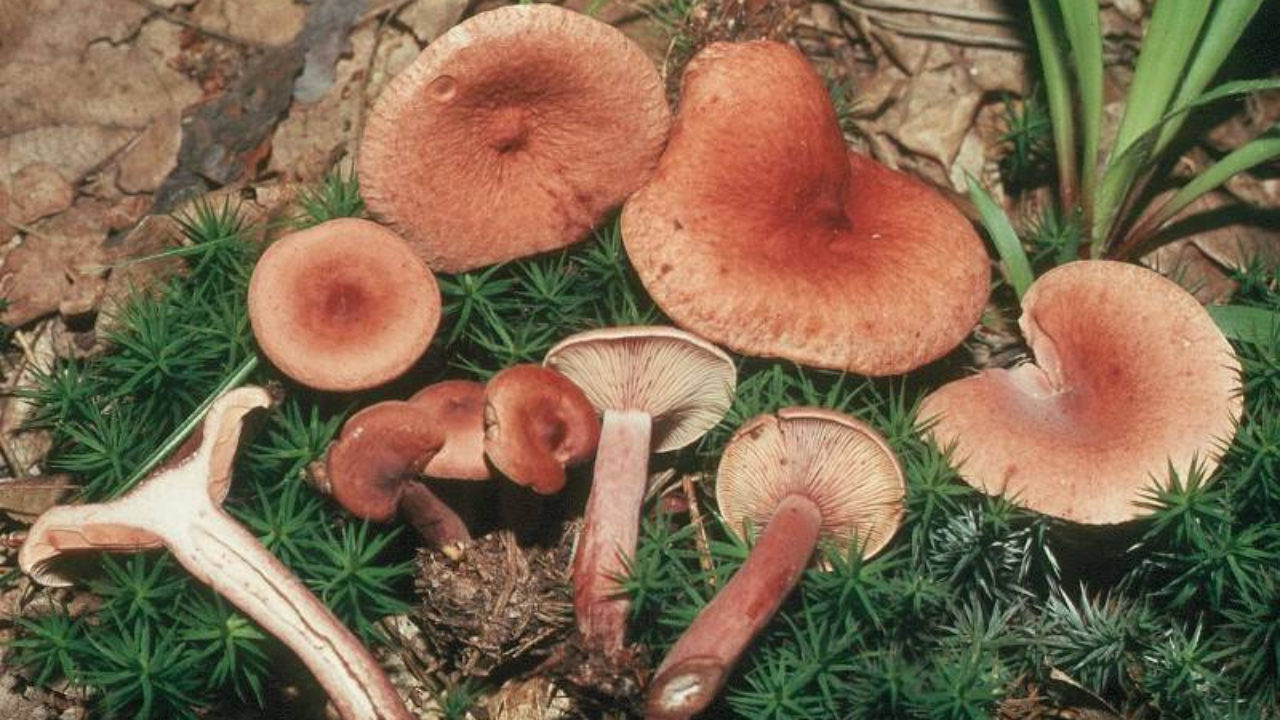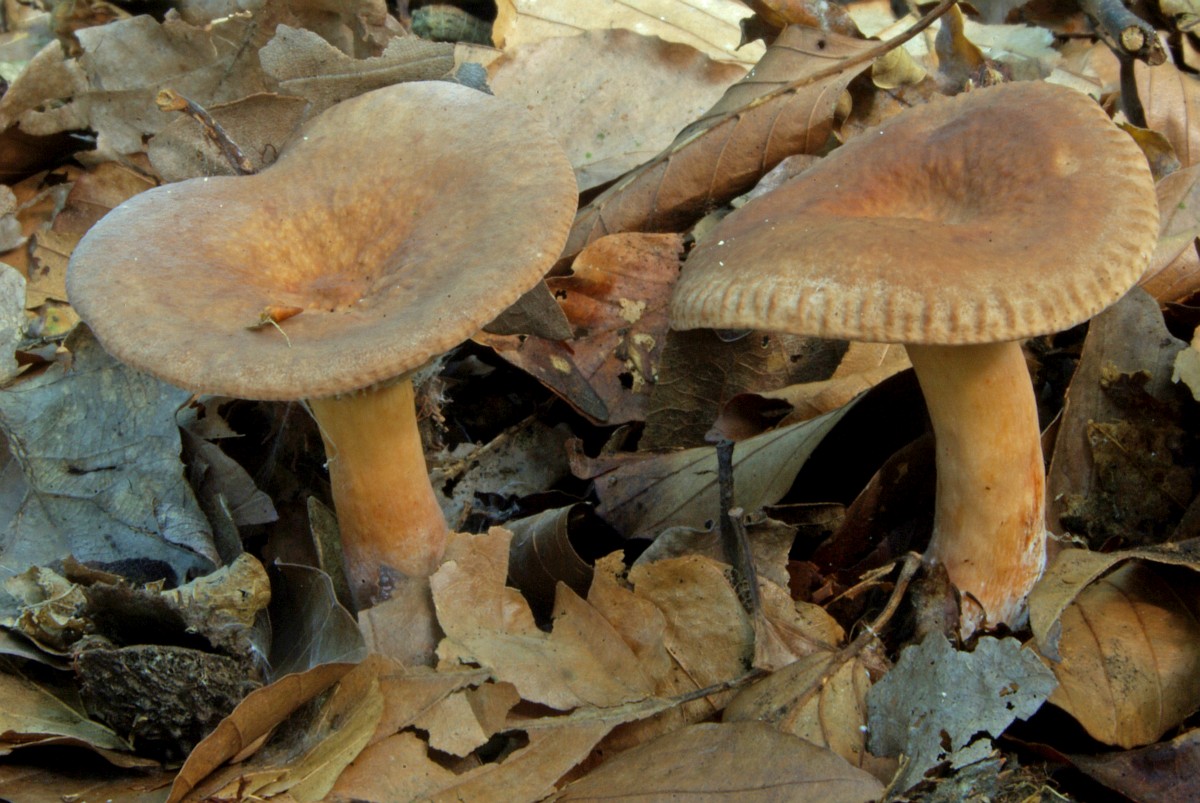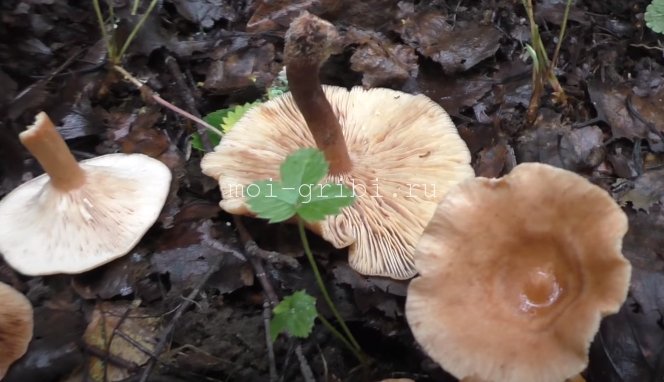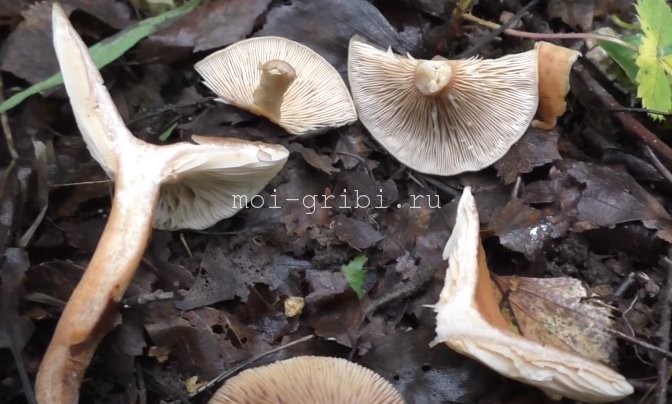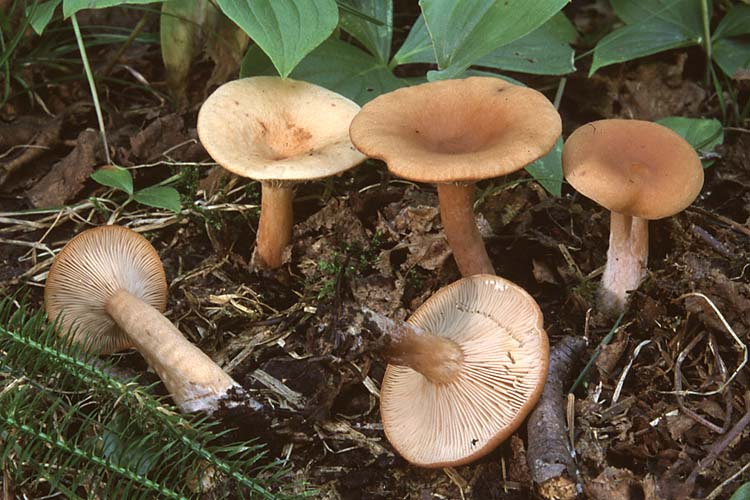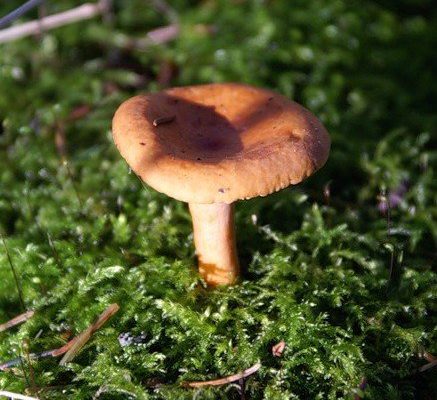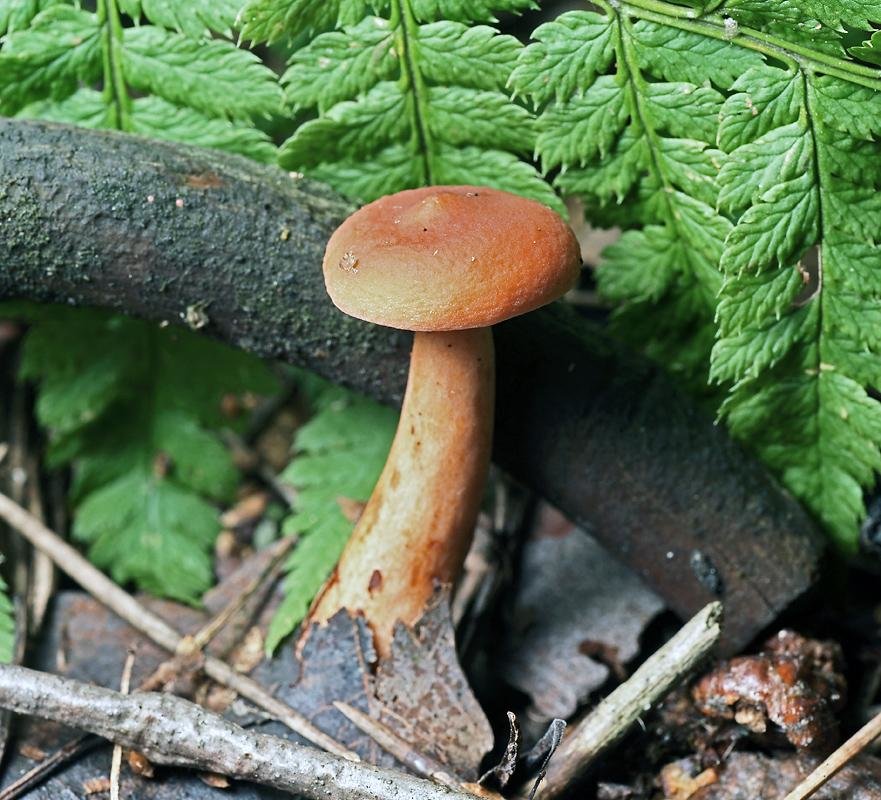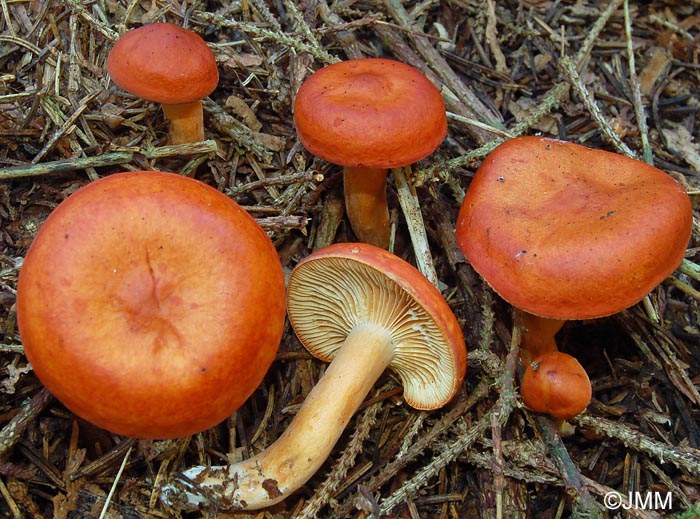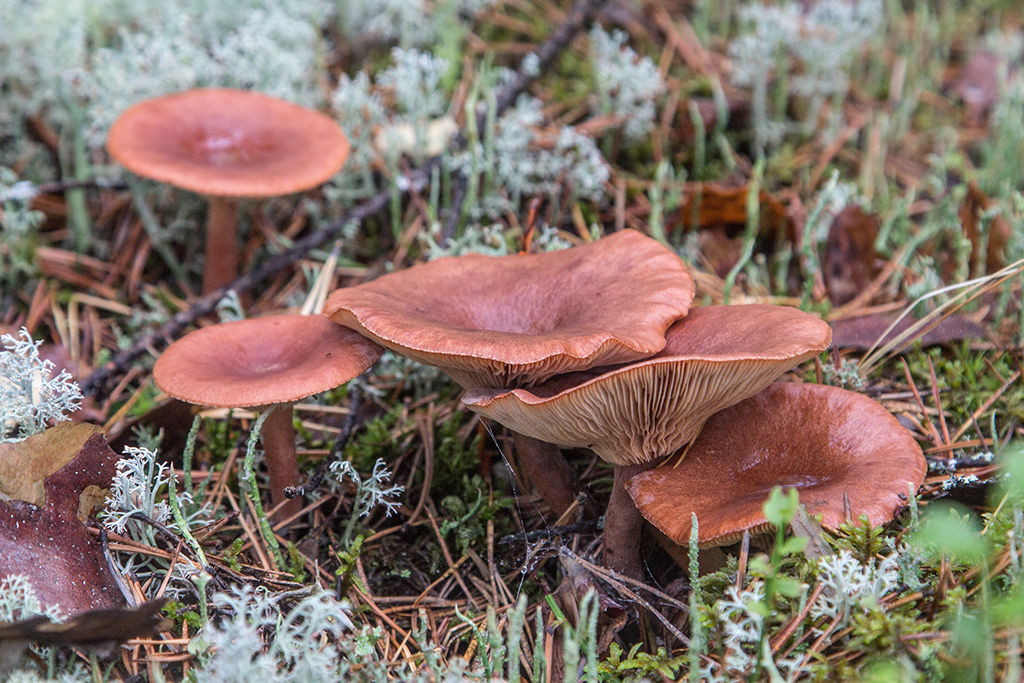Milk lover
| Group: | Lamellar |
| Plates: | Brown |
| Colour: | Brown or dark ocher |
| Info: | The plates darken when pressed, secrete juice |
| Department: | Basidiomycota (Basidiomycetes) |
| Subdivision: | Agaricomycotina (Agaricomycetes) |
| Class: | Agaricomycetes (Agaricomycetes) |
| Subclass: | Incertae sedis (indefinite position) |
| Order: | Russulales |
| Family: | Russulaceae (russula) |
| Genus: | Lactarius (Miller) |
| View: | Lactarius volemus (Warbler) |
It belongs to edible mushrooms of the 3rd or 4th category of nutritional value (according to various sources). It is believed that the milk lover can be eaten as raw materials, but many mushroom pickers are frightened off by the herring smell that characterizes mature specimens. In the west, it is considered a delicacy.
Description
The milk lover is distinguished by abundantly secreted juice, which quickly thickens and forms white drops on the surface of the mushroom.
Hat
The cap of the milk lover is very thick, often of irregular shape, in mature mushrooms with cracks. It reaches 15 cm in diameter. The surface is dry, evenly colored brown or dark ocher. In small milkweed, the cap is convex, and in the process of growth it unfolds upward and resembles a funnel. The edges of the cap in both young and adult specimens are bent downward.
Leg
The leg of the thresher is relatively thin (no thicker than 2 cm in diameter), about 10 cm long. It has the shape of a cylinder. The color is about the same as the hat or a little lighter. Often has a swelling in the middle.
Spore-bearing layer
The hymenophore or spore layer of the milk lover consists of plates. The plates are slightly lighter in color than the mushroom itself. If you press on them, the plates take on a darker color.
Pulp
The flesh of a reddish-brown milk mushroom or milk lover is yellowish, hard and brittle. It exudes a sap that is white at first, but quickly darkens in air to brown. In addition to changing the color of the juice, its thickening is also observed, it becomes viscous. Overripe specimens have the smell and taste of stale herring.
Spore powder
Milkweed has white spore powder in the plates. The spores are round and small. They are colorless individually, but appear white in large numbers.
Spreading
Milkworms can be found in both deciduous and coniferous forests. They grow both individually and in groups. Most often they can be seen on roads, in mountainous areas, along paths. Especially the miller loves humid places and the proximity of rotten stumps and moss. Euphorbia is more common in southern Russia.

Similar species
Euphorbia has no resemblance to poisonous mushrooms.
Here are some of his "doubles":
Hygrophoroid milky
It differs from milkweed in a sparse arrangement of plates. It is very rare, mainly near oak trees. Also edible.
Miller neutral
This mushroom is more brownish with dark areas. Its juice, unlike milkweed juice, has a yellow color. Edible.
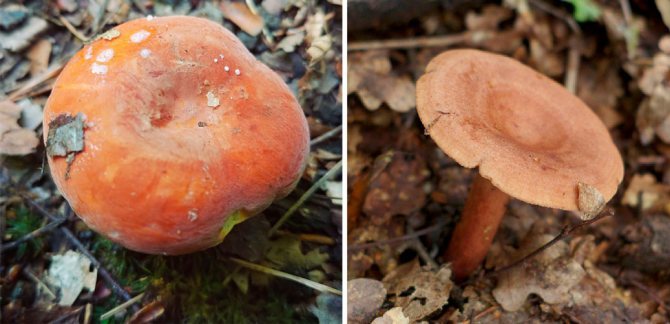
Miller pink-gray
Has a colorless juice. It smells like hay. Conditionally edible just because of its specific smell.
Has a more orange color and "pubescent" leg. It turns green on the cut. Edible.

An experienced mushroom picker can easily distinguish the spurge mushroom from the rest. Moreover, it comes across quite rarely.
How to cook properly
Euphorbia is great for pickling and pickling - it belongs to the fourth or third flavor category, so you should not eat it fried, stewed or boiled.
Before cooking, the mushroom does not need to be soaked, because it is not damaged by insects and does not have high acidity.
It is better not to use old mushrooms due to the strong smell and poor taste.
1 recipe

Mushrooms are delicious when salted
The simplest and most common cooking method is cold salting.
The collected fruit bodies are simply washed with cool water, and then they are laid out in layers in a wooden tub or barrel.
Each layer is sprinkled with coarse salt at the rate of 50 g per 1 kg of milkweed. When all the mushrooms are laid in layers, cover the surface of the last layer with gauze, on it - a wooden circle that matches the size (diameter) of the container and place the load on it. Leave in the cold for a month.
2 recipe
Some chefs cook Mushroom cream soup.
The algorithm of actions is simple: 200 g of butter are melted in a frying pan with half rings of onions until the latter acquires a golden color and a characteristic smell.
Next, 800 g of fruit bodies are fried with onions and oil for 15 minutes. In parallel with this, salt and ground pepper are poured into a saucepan with water.
When the contents boil, pour the food from the pan. After 5 minutes of boiling, 600 ml of milk with a high proportion of fat or heavy cream is poured into the container. On a note. The cream in the cream soup works better - it makes the taste "silky". After that, gradually, with stirring (to prevent the occurrence of lumps), 3 tbsp is poured out. flour.
Once the mixture is cooked, it can be given a little “rest” and mashed in a blender. This mushroom cream soup can be served with black bread, croutons or a finely chopped mix of fresh herbs.
Growing
It is possible to grow euphorbia mushroom at home under any species of trees, but nut plantings give the maximum germination and yield. In addition, such a neighborhood significantly increases the fruiting of crops due to the formation of mycorrhiza.
Milk lover spores can be purchased at the store and sown according to the instructions:
- Mix 15 g of seeds with 0.5 l of sand or dry soil (per 1 m²).
- Plow the ground under the tree, reaching the roots, to a depth of 5-15 cm.
- Distribute the mycelium over the area.
- Cover with garden, and preferably forest soil, mixed in equal proportions with humus.
- Pour 10 liters of water for each m² from a watering can with a fine spray.
- Mulch on top with earth and sawdust.
Did you know? Almost two thirds of the mushrooms sold on the world market areartificially grown in China.You can get the seed yourself. To do this, you need to find old mushrooms, without rinsing, grind in a meat grinder, add water and insist in a dark, warm place for 2 weeks. Over time, the cake must be removed from above, and the remaining liquid will be a solution of milkweed spores. Further, everything is done in the same way as with the purchased material, only the mycelium will be distributed over the area not in dry form, but by watering. The harvest of the red-brown milk mushroom can be expected in three months, then fruiting, subject to proper watering, will continue until the end of October.

Home cooking recipes
You can salt rubella mushrooms after soaking and boiling. Their use in cooking is very limited, they are only suitable for salting, they cannot be fried.
Primary processing
Only hitchhiking hats are used for food, the legs must be removed. They are fibrous and unusable. They can be cut while still in the forest without bringing them into the house. To get rid of bitterness, rubella is soaked for 48 hours or boiled for 2 hours.
Cooking
Boiled rubella is not suitable for food, this is an intermediate stage before salting.
Ingredients:
- 2 kg of mushrooms;
- 50 g of salt;
- 3 liters of water.
Preparation:
- Put a pot of water on the fire, bring the liquid to a boil.
- Put the pre-washed mushrooms in it. Add salt.
- Cook over low to medium heat for 2 hours.
- Over time, rinse the rubella under running cold water.
Pickling
Some culinary experts claim that rubella can be pickled. However, we strongly do not recommend doing this, since the composition of the mushroom contains substances that poison the human body, and how they will behave if you prepare a marinade and stew mushrooms in it is unknown.You should not pickle sweet milk mushrooms, the health consequences are not fully understood.
Freezing
Sweet milk is not suitable for freezing. Only unwashed mushrooms are sent to the freezer, since upon contact with water, they absorb it. Rubella must be boiled and washed.
Hot salting
After salting, rubella becomes crispy and aromatic. You can try the workpiece 2-3 weeks after preparation. Use as a stand-alone dish or toast in addition to vegetables. Before serving, boiled potatoes will come in handy.
Ingredients:
- 2.5 kg of boiled mushrooms;
- 100 g of salt;
- head of garlic;
- 8 sheets of currants and cherries;
- 5 sprigs of dill;
- 1 horseradish leaf.
How to salt rubella:
- Peel the head of garlic, cut into small slices.
- Put greens at the bottom of the bowl, add a tablespoon of salt.
- Layer mushrooms, dill, garlic.
- Make oppression: put a flat plate on top of the mushrooms, place a jar of water on top. Leave the workpiece in this form for a day.
- Transfer the mushrooms to glass jars, close with a nylon lid. If you wish, you can add fresh herbs to the salting.
- Place sealed jars in a cool, dark place.
Cold salting of rubella in jars
 A delicious appetizer is prepared with horseradish. Salted mushroom is served with sour cream, sprinkled with plenty of fresh herbs.
A delicious appetizer is prepared with horseradish. Salted mushroom is served with sour cream, sprinkled with plenty of fresh herbs.
Products:
- 500 g of mushrooms;
- 30 g horseradish root;
- 20 g salt;
- 2 cloves of garlic;
- 1 bay leaf.
Preparation:
- Soak the peeled mushrooms in water for a day or two.
- Cut the passing, horseradish and garlic into small slices.
- Stir food, add spices.
- Place the components in jars, press down with oppression. Refrigerate for 24 hours.
- Close the jars with nylon lids and lower them into the cellar. Harvesting can be done in 30-40 days with fried or boiled potatoes.
Frying and drying
You cannot fry and dry these mushrooms, you can get poisoned. However, some culinary experts assure that if the rubella is well soaked and boiled, finely chopped, they are suitable for frying.
Description and photo of Bitter
As mentioned above, many mushroom pickers prefer to bypass the bitter side. And all because it is incredibly similar to a toadstool. However, it seems so only at first glance, if you do not know the nuances of the structure of the mushroom. Let's find out how to distinguish a bitter from other representatives of the forest. Indeed, in fact, it is not as difficult as it might seem at first glance. Common names: Red Bitter, Bitter Milk, Gorchak, Goryanka, Putik, Sukharka.
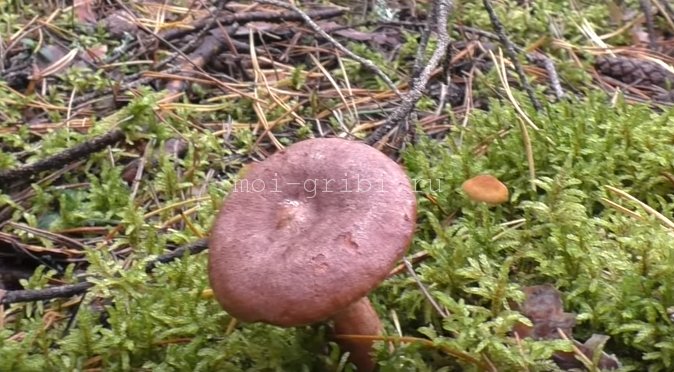
Hat
Bitter is a striking representative of the forest, and naturally, it is easy to spot it in the forest thicket. This mushroom has a very remarkable head. If you look at it carefully, you can see that it is bright enough. Most often it has shades of orange, brown or brown. In fact, it all depends on the soil in which the mushroom grows. If it is acidic, the mushroom becomes darker, if it is limestone, the cap of the mushroom is rather light.
As for the size of the cap, it can reach a maximum of 15 cm in diameter.However, most often there are specimens that are not so impressive in size. Average approximately 10, maximum 12 cm in diameter.
The hat is quite fleshy, if you touch it with both hands, you will feel elasticity and full of pulp. The hat smells pleasantly of mushroom champignon and other pleasant bouquet of aromas.

As for the skin of this forest dweller, it is quite dry and slightly slimy. However, if the mushroom does not grow in the shade, but prefers forest edges or clearings, then the cap becomes completely dry and cracks.
In general, the bitter has an umbrella-shaped hat with a pronounced dome. However, with age, its edges begin to rise, as a result of an uneven rise, the pulp begins to crack, and the mushroom does not look very presentable. Flies begin to settle inside.
However, this happens quite rarely and only under the direct influence of sunlight.
Leg
The stem of this mushroom is rather thin relative to the cap. And she hardly holds such a weighty mushroom. In length, it reaches about 8 cm. In diameter it rarely reaches 2 cm, usually from one to one and a half. The stalk is usually lighter than the cap, however, if the soil is very acidic, the stalk becomes darker.
It thickens slightly closer to the mycelium. With age, the leg becomes almost hollow, it can hardly withstand the cap. However, at a young age, it is very elastic and no less tasty. It also gives off a very pleasant smell.
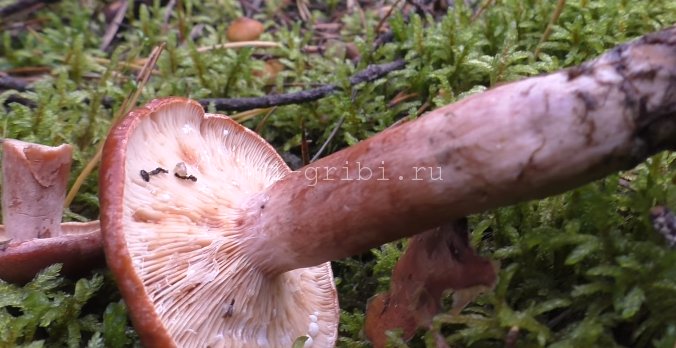
Pulp
As for the pulp, it has a white tint, but when it interacts with oxygen, it quickly darkens and becomes beige and even orange. If you make a cut, then flies and other insects will quickly fly to the smell, because a bitter for them is a favorite delicacy.
If you look under the hat, you can see very thin white and pink plates. Also, over time, these plates can also acquire a brown color. It is believed that the standard size of such plates is quite thin, however, depending on the nuances of growth, the plates can become wide. Spores of olive shade and spore powder are hidden there.
The mildness is bitter on the palate, but with proper home processing, it will become truly tasty, aromatic and nutritious.
Raw mushroom tastes hot, like you tasted pepper. Also, the pulp on the cut gives a milky white juice, and the smell is similar to wood.

Growth calendar
When should you go looking for a bitter taste?
In fact, this mushroom has a very clear framework for growth and development. It is believed that the bitter begins to grow actively from June, when a bright and active sun appears and is already warm enough. However, as it grows and develops, the bitter has a fairly large seasonality. It is believed that from June it grows to mid-September, after which this mushroom stops actively growing and begins to dry out.
However, if the spring is very warm, then the bitter can begin to grow from May.
The same applies to warm autumn, with a favorable development of events, the bitter can grow until the end of October.
It is believed that the optimal time to harvest this mushroom is from mid-August to mid-September. Then the mushrooms are already gaining their strength, have the best possible characteristics in terms of quality and composition. The same goes for taste characteristics. Therefore, you should go on a mushroom hunt at this time.

Application in medicine
The euphorbia mushroom has a large number of beneficial properties, thanks to which it is widely used in folk medicine. The most valuable is milky juice, which has a powerful antitumor effect.

Fresh mushrooms contain ethanol extract, which is often used in the fight against various malignant tumors, including cancer. The presence of cortisone in the composition of tissues allows it to be used in the composition of agents for combating inflammation and rheumatism.
Tincture of milk lover is taken in 1 tsp. 3 times a day for varicose veins, hemorrhoids, gout, otitis media, bronchitis, fever, sore throat, gastrointestinal diseases and inflammatory processes.
With a cold, the nasal mucosa is lubricated with an oil composition. External use of the tincture helps to solve the problems of skin inflammation, cure burns, allergic rashes, and more.
- In addition, the red-brown mushroom also performs a number of other functions:
- blocks the spread and removes bad cholesterol;
- has an antioxidant effect;
- helps in the restoration of the microflora of the digestive tract;
- helps replenish protein and protein stores in a healthy diet.
Milkweed mushroom tincture recipe in oil
To prepare a milkweed tincture in oil, the mushrooms must first be dried. To do this, they are cut into plates 1 cm thick and hung in shaded, well-ventilated places. You can also use an electric dryer.
Important! Before use, the tincture must be shaken thoroughly until smooth.After the raw material has completely dried, it is ground into a powder with a coffee grinder or blender and poured with linseed or olive oil at the rate of 0.5 liters of oil per 3 tbsp.
l. mushroom powder. The container is tightly closed and left to infuse in a warm, dark place for two weeks. You do not need to filter the composition. It can be stored in the refrigerator for several years.
After the raw materials have completely dried, they are ground into powder with a coffee grinder or blender and poured with linseed or olive oil at the rate of 0.5 liters of oil per 3 tbsp. l. mushroom powder. The container is tightly closed and left to infuse in a warm, dark place for two weeks. You do not need to filter the composition. It can be stored in the refrigerator for several years.
In which forests to collect mushrooms Sukhark
In which forests is it worth collecting bitter? Where is she hiding?
Many mushroom pickers know that the bitter is used to living in both deciduous and coniferous forests. The fact is that this mushroom is not picky at all. He will feel equally good in any development of events.
This mushroom is ideal for growing around marshes and bodies of water, and also works well in growth and development on dry soils.
Bitter is not selective in the place of growth, the main thing for her is to avoid direct sunlight. But even if it is located in a clearing, this mushroom will hide behind tall grass.
Bitter behaves very well in the shade. It grows rapidly, its growth is active. In the shade, it grows to its maximum size. As for the composition of the bitter, limestone soil is considered the most favorable for the growth and development of this fungus. It is so nutritious that mushrooms grow here like by leaps and bounds. With acidic soils, things are worse, therefore, in coniferous forests there are much less bitters than in mixed and deciduous ones.
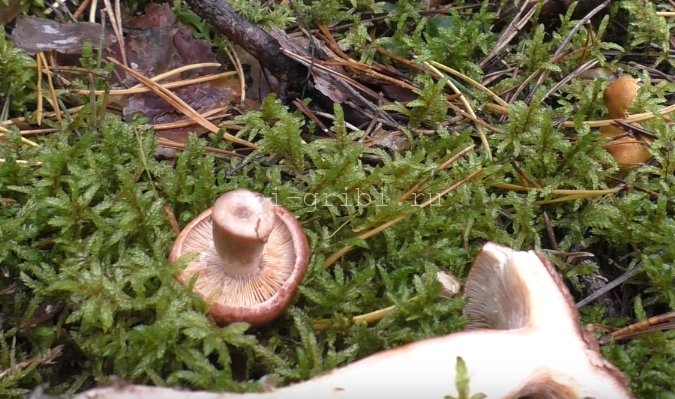
However, even in spite of this fact, the bitter tries to linger among the pines and firs.
It does not enter mycorrhiza with trees, it feels great regardless of the species of trees growing nearby.
Bitter is believed to be a very heat-dependent mushroom. Unfortunately, if the weather is cold, the bitter will quickly die, since the cold is deadly for it. Therefore, it grows either in central Russia, or in its eastern and southern parts. But to the north, this mushroom can be found very rarely.
But still, the bitter is not too picky, and if its spores are brought to the northern land, it will grow there, however, it will not bear fruit as actively as in the southern regions.
Similar species
The rubella has a lot of twins. These species are not only similar to each other in appearance, but also in some other characteristics. Fortunately, the rubella has no poisonous counterparts. This means that you can collect it without fear for your life and health. What species are these mushrooms similar to?
Bitter
Bitter is not as common a mushroom as rubella. He also belongs to the genus "milkman", the family "russula".
The largest accumulation of these mushrooms can be found in the northern part of Russia, namely in Karelia.
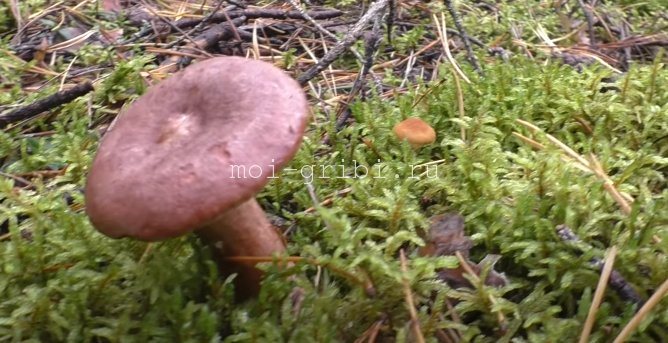
The edible mushroom belongs to the fourth category. Has a bright red neat hat that rises up over time. And also a red, but somewhat light leg. The growth time of mushrooms is from mid-June to September. In the middle of the cap there is a characteristic tubercle, which distinguishes the bitter from the rubella.
The taste of this mushroom is quite bitter, but after a properly carried out heat treatment, it becomes acceptable for cooking.
Spurge
Not many people know that under the name "spurge" there is not only a plant, but also a mushroom. It is, however, rarely met, since it is very unpretentious in its height. The mushroom is edible and has a fleshy cap, which can reach 15 cm in diameter. It is rather convex, rarely flat.
There is no mucus on it, so the cap sometimes cracks when exposed to direct sunlight. The pulp is quite dense, the knife and fingers easily sink in it.Prefers coniferous, mixed and deciduous forests for growth, also spreads along roads.
In terms of its taste, it is acceptable, however, it does not have the most pleasant aftertaste. The mushroom has a bright orange color, so it is clearly visible from a distance, even under a carpet of leaves.
It got its name from the white juice that is released when the pulp is cut in half. Finding this mushroom in the forests is not so easy. It is widespread, but still, somewhat unpretentious, looking for an ideal soil and conditions for growth. If they do not meet the requirements, it quickly dies off. Therefore, this mushroom is very difficult to find. However, it is widely used for medicinal purposes, which is why traditional medicine respects it very much.
Difference from false, inedible mushrooms
This fruit is difficult to confuse with other types of mushrooms. But inexperienced lovers of quiet hunting can easily be identified by confusing the leaflet with a gray-pink milky, which does not emit such an amount of milky juice and has the smell of dry grass.
The gray-pink milky belongs to inedible mushrooms, so you should consider it in the photo very carefully. Euphorbia is quite similar to some of the milky relatives. For example, the hygrophoroid lactic acid is edible, does not change the color of the milky juice, and its plates are located much less frequently than in the smoothie.
The conditionally edible non-edible lactarius is much smaller in size, and the cap is not covered with small cracks.
Interesting Facts

Here's what else can be said about the camphor mushroom:
- According to some sources, camphor mushrooms can be poisoned if prepared incorrectly, since this mushroom contains muscarine, which is also found in fly agarics.
- However, no fatal cases of mushroom poisoning have been described.
- Symptoms of poisoning are limited to the symptoms of gastroenteritis: nausea, vomiting, diarrhea.
- The unpleasant smell and tasteless milky juice of this mushroom scares away insects, so camphor lactic acid is never a worm.
Many sources mention that it is better not to collect camphor milk at all, because of all the milk mushrooms, it is the most dangerous in terms of possible poisoning. However, mushroom pickers still use it in the form of pickles, in which, when properly prepared, the milk mushroom is not toxic. But with any method of processing, the mushroom is not recommended to be given to children, allergy sufferers and patients with chronic gastritis or duodenitis.
Useful properties of the mushroom
The fruiting bodies of the woods contain a large amount of active substances that have a healing property on the human body. Among them, it is worth highlighting volemolid, which is also known as mushroom ergosterol. Also worth noting here are sterols known in mushroom science. They are also found in sea sponges and corals. It is impossible not to mention the presence of sugar alcohol, volemitol.
In folk medicine, milkweed juice is often used. It must be used externally in oncology in order to cure a tumor. Fresh fruiting bodies contain ethanol extract, which demonstrates anti-cancer activity and suppresses the development of sarcoma.
Milkwort tissue contains cortisone, which is why it is often used as part of antirheumatic and anti-inflammatory drugs.
Preparation
With the right approach to the preparation of the milk jug, such a mushroom will amaze you with its original taste. A specific feature of milkweed is the presence of a fishy odor, which becomes more noticeable with the age of the fungus. During the cooking process, the smell becomes even more pronounced. As for the group of young mushrooms, they have a more pleasant and rich taste.
The mushroom can be pickled, stewed, fried, dried and even salted. Before making salting, it is worth soaking the spurge well. This will get rid of bacteria and give the mushrooms a special flavor. It is worth noting that the milk jug is never damaged by the larvae, so more and more mushroom pickers like to use it raw with salt.
If you want to process the mushrooms, cold salting is the best solution.Rinse the red milk milk jug under water and place in a deep container in layers. Each of them must be sprinkled with salt. For 3 kg of mushrooms, 150 grams of salt is needed. After that, put the container in the refrigerator for a month. After this period, you can taste the mushrooms. If they are too salty, they can be diluted with boiled water. They are great for salads and pizzas.
How to distinguish milk from milk
The main trouble for a novice mushroom picker is to collect a full basket of pseudo-weights, brag to neighbors, spend time cooking, and then bashfully throw the crop into the trash. It is much easier to find them: experienced "hunters" pass by, not paying attention to these mushrooms. So you need to know the special signs that a milkmaid can boast of. The mushroom really looks like a lump, but you can still identify it.
Firstly, the breast is fringed, with concentric zones, and the “fake” is smooth. Secondly, the "milk" secreted by the load quickly turns yellow in the air. The violin juice retains its original color. Thirdly, the flesh of the milkfish is denser and drier. And the caps of the mushrooms, despite the striking similarity, have a slightly different shape: the edges of the mushroom are slightly tucked down, at the squeak they are slightly curled up.
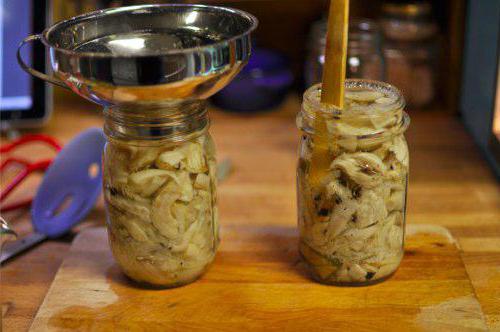
Millechnik: photo and description of the genus of mushrooms. What do milkmen look like?
Millers are mushrooms with thin or thick fleshy, dense, but fragile fruit bodies, mostly of medium or large size. Their cap and stem are homogeneous (homogeneous) and do not separate from each other without breaking, as, for example, in a champignon. There are stocky mushrooms with a thick stem, approximately equal in length to the diameter of the cap (Lactarius deliciosus, Lactarius pubescens, Lactarius turpis), and there are also species in which a small cap is placed on a long, relatively thin stem (Lactarius camphoratus, Lactarius lignyotus). Both the private and the general veil are absent in fungi of this genus.
The cap of the lactarius can be funnel-shaped, depressed, convex-outstretched, or convex. In young mushrooms, it is straight or convex with the edge tucked down. White or brightly colored (yellow, orange, gray, pink, brown, blue, purple, olive-black), with a wavy, straight or ribbed edge. With age, some mushrooms change the color of their fruit chalk.
The surface of the lactic cap is dry or slimy, smooth, scaly, fleecy or velvety, monochromatic or with concentric circular zones and grooves - lacunae. The size of the cap is from 8 to 40 cm (Lactarius vellereus). In a stunted lactarius (lat. Lactarius tabidus) and a dark lactarius (lat. Lactarius obscuratus), the cap is capable of swelling, absorbing water.
The miller is stunted.
The flower is pink.
The hymenophore of these fungi is lamellar. The lamellar plates descend to the pedicle to varying degrees, attaching to it strongly in some species, insignificantly in others. Plates with anastomoses or notched, are both white and colored in bright colors: pink, bluish, pale ocher, cream. Can change color when touched. For example, the plates of the lilac lilac (lat.Lactarius violascens) are initially white or creamy yellow, when squeezed they turn purple.
Spruce ginger.
A characteristic feature of the lactarius and russula in general is the net pattern on their spores. The cells themselves, intended for reproduction, are more often spherical, broadly oval or oval in shape. Spore powder is white, ocher or yellowish cream.
Spores of the aromatic lactarius under the microscope.
The leg of the lactarius is attached to the cap in the center; its shape is regular cylindrical, flattened or narrowed towards the base. It is white or the same color as the cap, sometimes hollow inside, often with chambers or full. The surface is smooth, dry, less often slimy and sticky.
Some species have depressions (lacunae), colored somewhat darker than the rest of the skin of the leg. The height of the leg of the lactarius is 5-8 cm, its diameter is 1.5-2 cm.
Miller is neutral.
The pulp of the lactarius is fragile, white or with a brownish, creamy or fawn tint. It can change color when exposed to air.It contains conductive thick-walled hyphae with milky juice.
The color of the milky sap and its change in air are an important systematic sign by which the species of the genus are distinguished. Most often it is white, but in some species in the air it slowly turns green, gray, yellow, becomes purple, red, etc. In the North American blue milkman (Latin Lactarius indigo), the juice, like the entire fruit body, is blue.
Bitter.
The blue milkman.
Description and photo of rubella
How to understand that in the forest in front of you is a rubella or, as it is called, a sweet milk mushroom? To do this, you need to know exactly what this mushroom might look like. However, there are several nuances. Depending on the type of soil, a forest dweller may have slightly different characteristics than those described in the reference books. Therefore, we will consider several options at once for how a rubella may look. Synonyms - Sweetish Milk, Sweet Milk, Poputa.
Hat
The first thing that the mushroom picker looks at is, of course, a hat. In young mushrooms, it is rather convex and has the shape of an umbrella. However, with age, the edges begin to rise unevenly. Because of this, the cap begins to tear at the edges, and the flesh darkens when it interacts with oxygen.
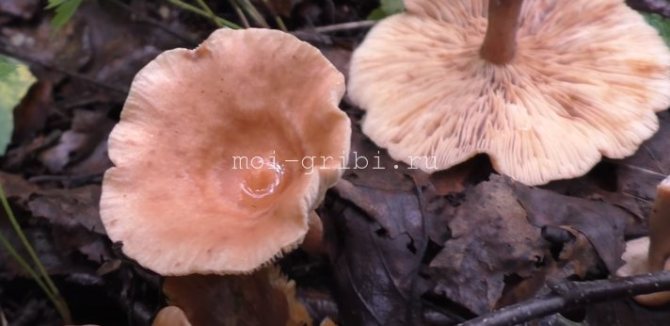
However, from this it does not cease to be edible. The diameter of the cap reaches 8 cm. However, in calcareous soils, which are incredibly useful for this fungus, the cap can grow up to 12 cm. With age, when the edges of the cap rise, they even begin to bend slightly inward.
The color of the fungus can be either dark red or bright yellow, depending on the composition of the soil. If you try the hat, you will realize that it is quite fleshy and elastic, and your fingers literally fall into it. A pleasant mushroom aroma comes from the cap, which speaks of edibility.
Leg
Such a fleshy and dense cap rests on a rather thin leg, the length of which reaches 10 cm. It is cylindrical, compacted to the base.
A characteristic feature that makes it possible to distinguish the rubella from any other mushrooms is that its stem is much lighter than the color of the cap. And this always happens, regardless of the soil where the mushroom grows.
With age, the leg ceases to be so stable and dense, it becomes empty inside and hardly holds the cap back. Therefore, very often in the forests you can find a situation when the leg broke under the weight and weight of the cap and therefore the mushroom dries quickly.
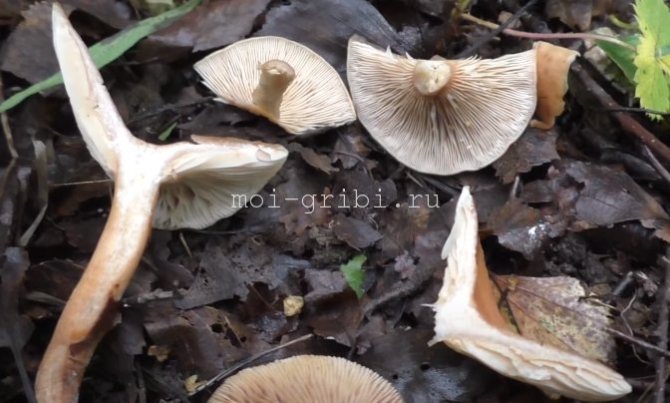
Pulp
As we said above, the flesh of this mushroom is quite dense. However, it should be noted that it is also very elastic. If you cut the cap of the mushroom in half, you will see white juice coming out of the pulp. The pulp itself is white, but when interacting with oxygen, it begins to darken constantly, until it becomes completely brown.
If the rubella is overripe, then a somewhat unpleasant smell of rot begins to emanate from it. The pulp inside becomes quite fragile in structure and at the same time loose. This means that it is better not to take such a mushroom for food.
If you look under the hat, you can see the neatly arranged plates. The fact is that rubella is a lamellar mushroom. The plates are neatly concentrated at the very bottom of the cap, they are located quite often. Their color at the beginning of growth is white, and then turns dark yellow.
Growth time
The sweet lump chooses the time to grow from mid-June to about the end of September. The mushroom is thermophilic, so if the beginning of summer turned out to be cold, it begins to ripen much later. If the autumn is warm, then the lump will delight you until the very end of October.

He loves the sun's rays, but not direct, therefore, in warm meadows, where the light of the sun breaks through the grass and grows very actively. But when direct sunlight hits the cap, it begins to crack. Moisture appears in the cracks, insects rush there. It is no longer possible to collect such a mushroom.
Miller is also very dependent on moisture, so he loves places along forest lakes, rivers, and even sometimes settles along swamps. In general, the mushroom has its own requirements for the conditions of growth and development.However, it can be called unpretentious, since it adapts to the conditions in which it grows significantly.
Where can I find
In the central zone of Russia, rubella is found everywhere, it remains only to look for it carefully. Mushrooms, as mentioned above, are quite unpretentious, therefore they bear fruit actively, and choose both deciduous and coniferous forests for their growth. They can be found among mixed forests. Look carefully where moss is predominant. The mushroom loves to settle on it.
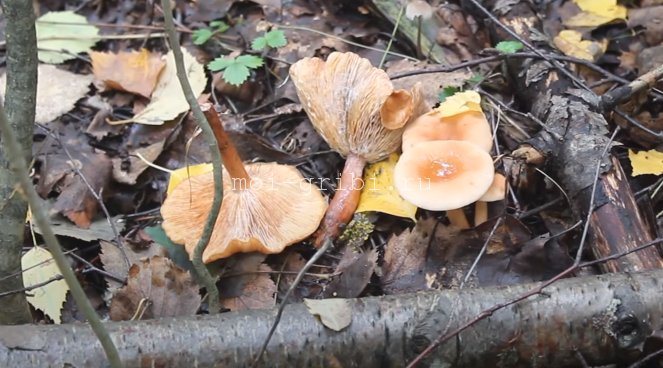
He loves the shadow, but so that the sun's rays shine through it, so he chooses not densely planted forests. It can also be found in meadows and forest edges.
Sometimes they are found along the banks of rivers and ponds. In general, the mushroom settles where it finds acceptable conditions for its existence.
In places where conditions for some reason are not suitable for growth, it bears fruit for one, maximum two years, after which the mycelium dies off.
What is the danger of a mushroom
The rich chemical composition not only helps to fight diseases, but is the reason for the presence of a number of contraindications and warnings in the matter of its use. Euphorbia mushroom should not be consumed by pregnant women, children under 7 years old, breastfeeding mothers.

- In case of intolerance to one or more of the components of the fungus, side effects may occur:
- itchy skin;
- atopic dermatitis;
- upset gastrointestinal tract;
- allergic rhinitis or ARVI;
- a sharp rise in temperature;
- headache;
- cough, shortness of breath.
People suffering from kidney diseases, cholelithiasis, gastritis and stomach ulcers in an aggravated form should take milkweed-based medications with extreme caution. It is not recommended for hypertensive patients to consume more than 1 hour.
l. infusion per day. The fungus has a stimulating effect on the nervous system, so it should not be eaten in any form later than three hours before bedtime.
The red-brown milk mushroom is a tasty and healthy product, but it is extremely difficult to find it. Often, in search of several mushrooms, you have to walk tens of kilometers through a marshy area, however, believe me, they are worth the effort.
Summing up
Do not rely on traditional medicine dogmas alone. Before using the support as part of a treatment or simply as part of a meal, it is worth analyzing your condition and discussing this decision with a nutritionist, therapist or gastroenterologist.
In addition, the mushroom itself is quite difficult to get: it is rarely found in accessible points of the forest. But even an old euphorbia found can disappoint with its specific taste.
The nutlet belongs to the genus Millechniki, which is a member of the russula family. A feature of the mushroom is the absence of strong bitterness, which is characteristic of milkmen. In addition to good taste, the fruit has healing properties, because it contains biologically active substances.
It is difficult to find this mushroom in the forests of our country - it is considered a rather rare species. In order not to miss the opportunity to put the nut mushroom in your basket on occasion, you should carefully read its photo and detailed description, remember the characteristic features.


